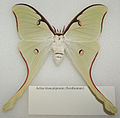| Actias | |
|---|---|
 | |
| An assortment of mounted Actias moths and their cocoons | |
| Scientific classification | |
| Kingdom: | Animalia |
| Phylum: | Arthropoda |
| Class: | Insecta |
| Order: | Lepidoptera |
| Family: | Saturniidae |
| Tribe: | Saturniini |
| Genus: | Actias Leach 1815 |
| Species | |
Numerous, see text | |
| Synonyms | |
| |
Actias is a genus of Saturniid moths, which contains the Asian-American moon moths. Long tails on their hindwings are among their distinctive traits. Other moths with similar appearance are Copiopteryx , Argema and Eudaemonia .
Contents
- Species
- Selected former species
- Galleries
- Eggs
- 1st Instar
- 2nd Instar
- 3rd Instar
- 4th Instar
- 5th Instar
- Cocoon
- Adult
- References
The majority of species in this genus feed on the leaves of sweetgum, pine, or similar trees. As with all Saturniids, adult Actias moths lack functional mouthparts so their lifespan after emergence from the cocoon only ranges from a few days to a week.



























